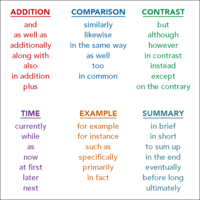
Text Structure Signal Words and Examples
Quiz
•
English
•
9th - 12th Grade
•
Practice Problem
•
Medium
+6
Standards-aligned
Moritza Termin
Used 251+ times
FREE Resource
Enhance your content in a minute
25 questions
Show all answers
1.
MULTIPLE CHOICE QUESTION
30 sec • 1 pt
Choose the signal words that indicate chronological order.
first, next, finally, 8:30, after
cause, effect, as a result of, because
problem, solution, promise, struggle
compare, contrast, similar, different
Tags
CCSS.RI.5.5
CCSS.RI.6.5
CCSS.RI.7.5
CCSS.RI.8.5
CCSS.RI.9-10.5
2.
MULTIPLE CHOICE QUESTION
1 min • 1 pt
Choose the signal words that indicate compare and contrast.
therefore, cause, effect, consequently
later, then, next, Monday
similar, different, common, on the other hand
possibility, struggle, hope, problem
Tags
CCSS.RI.5.5
CCSS.RI.6.5
CCSS.RI.7.5
CCSS.RI.8.5
CCSS.RI.9-10.5
3.
MULTIPLE CHOICE QUESTION
1 min • 1 pt
Choose the signal words that indicate cause and effect.
next, after, then, first, last
struggle, promise, problem, solution
consequently, as a result of, so, therefore
similar, common, compare, contrast
Tags
CCSS.RI.11-12.5
CCSS.RI.6.5
CCSS.RI.7.5
CCSS.RI.8.5
CCSS.RI.9-10.5
4.
MULTIPLE CHOICE QUESTION
1 min • 1 pt
Choose the signal words that indicate problem and solution.
first, last, next, after
cause, as a result of, consequently
compare, similar, both, alike
threat, difficulty, possibility, hope
Tags
CCSS.RI.11-12.5
CCSS.RI.6.5
CCSS.RI.7.5
CCSS.RI.8.5
CCSS.RI.9-10.5
5.
MULTIPLE CHOICE QUESTION
1 min • 1 pt
"The beloved children's writer, Shel Silverstein is well known for his three books of children's poems. The first book, Where the Sidewalk Ends was first published in 1974. The second book, A Light in the Attic, came out seven years later in 1981. The final book, Falling Up, was published in 1996."
What words signal the author's organizational pattern?
Tags
CCSS.RI.2.5
CCSS.RI.3.5
CCSS.RI.4.5
CCSS.RI.5.5
CCSS.RI.6.5
6.
MULTIPLE CHOICE QUESTION
1 min • 1 pt
Moths and butterflies often look similar. Both have large wings and long, thin bodies, and both start their lives as caterpillars. However, butterflies usually have brighter colors on their wings than moths. Also, butterflies are most active during the day, while moths are generally creatures of the night.
What words signal the author's organizational pattern?
Tags
CCSS.RI.11-12.5
CCSS.RI.6.5
CCSS.RI.7.5
CCSS.RI.8.5
CCSS.RI.9-10.5
7.
MULTIPLE CHOICE QUESTION
30 sec • 1 pt
To make a snowman, start by rolling a big ball for the body. Then roll a smaller ball and put it on top of the big ball to use as the head. Next, find two sticks to use as arms. Then you can use objects such as coal, a carrot, and raisins to make the face. Add a hat and your snowman is complete!
What words signal the author's organizational pattern?
Snowman
Sticks, coal
Start, next, then,
Make, use, add
Tags
CCSS.RI.11-12.5
CCSS.RI.6.5
CCSS.RI.7.5
CCSS.RI.8.5
CCSS.RI.9-10.5
Create a free account and access millions of resources
Create resources
Host any resource
Get auto-graded reports

Continue with Google

Continue with Email

Continue with Classlink

Continue with Clever
or continue with

Microsoft
%20(1).png)
Apple
Others
Already have an account?
Similar Resources on Wayground

20 questions
Grade 3 Unit 3 Read and Think 1&2 Animals on the Red List
Quiz
•
8th Grade - University

21 questions
Eng23205 M.3 Review U.1-2
Quiz
•
9th Grade

20 questions
Australia
Quiz
•
9th - 12th Grade

20 questions
Past simple and past continuous
Quiz
•
7th - 12th Grade

20 questions
Unit 6 M3 Passive voice
Quiz
•
9th Grade

20 questions
mu như cc
Quiz
•
12th Grade

20 questions
Spotlight 9 5-5f
Quiz
•
9th Grade

20 questions
Present, Past or Perfect Tenses
Quiz
•
6th - 10th Grade
Popular Resources on Wayground

10 questions
Forest Self-Management
Lesson
•
1st - 5th Grade

25 questions
Multiplication Facts
Quiz
•
5th Grade

30 questions
Thanksgiving Trivia
Quiz
•
9th - 12th Grade

30 questions
Thanksgiving Trivia
Quiz
•
6th Grade

11 questions
Would You Rather - Thanksgiving
Lesson
•
KG - 12th Grade

48 questions
The Eagle Way
Quiz
•
6th Grade

10 questions
Identifying equations
Quiz
•
KG - University

10 questions
Thanksgiving
Lesson
•
5th - 7th Grade
Discover more resources for English

10 questions
Thanksgiving Trivia Challenge: Test Your Knowledge!
Interactive video
•
6th - 10th Grade

20 questions
Week 16 Pre-AP/English I Grammar and Concepts Review
Quiz
•
9th Grade

12 questions
Thanksgiving Poll
Lesson
•
5th - 9th Grade

50 questions
STAAR English 2 Review
Quiz
•
10th Grade

12 questions
Thanksgiving trivia
Quiz
•
3rd - 10th Grade

18 questions
author's purpose
Quiz
•
10th Grade

15 questions
Making Inferences
Quiz
•
7th - 12th Grade

14 questions
Homonyms Quiz
Quiz
•
KG - University
